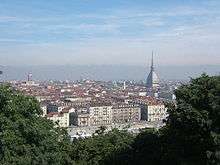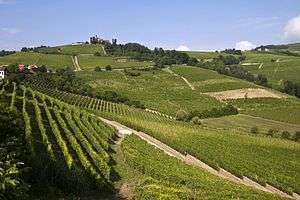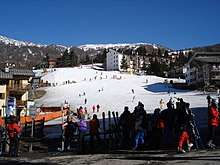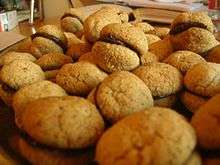Piedmont
Piedmont (Italian: Piemonte) is a region in the northwest of Italy, next to the border with France. The main city is Turin (Torino), which was host to the 2006 Winter Olympic Games. Piedmont is surrounded on three sides by the Alps, including the Monviso, where the Po River rises, and the Monte Rosa. It borders with France, Switzerland and the Italian regions of Lombardy, Liguria, Emilia-Romagna and Aosta Valley.
- For other places with the same name, see Piedmont (disambiguation).
The area is justly famous for its wines, which include some of the best produced from Italy, such as Barolo, Barbaresco, Barbera, Dolcetto and Moscato D'Asti. Its local cuisine is renown throughout Italy and the precious white truffles of the region have been compared to gold because of their cost and delicacy.
Piedmont consists of the provinces of Alessandria, Asti, Biella, Cuneo, Novara, Turin, Verbano-Cusio-Ossola, Vercelli.
Cities

- 🌍 Alba - the entrance to the Langhe, the home of Nutella Chocolate spread, otherwise best known for its ancient Roman walls, elegant wines and exotic truffles
- 🌍 Alessandria - a city and province in the southeast, the province also containing Acqui Terme, a beautiful Roman town famous for its hot sulphur springs and ancient baths
- 🌍 Arona - the southernmost port on Lake Maggiore
- 🌍 Asti - centre of the Piedmont wine area, an important medieval republic known as “City of 100 Towers”, of which around 15 still stand in the old historical walled city
- 🌍 Barolo - a small town south of Alba, world famous for its red wine
- 🌍 Biella - a town and province with a strong tradition in wool and clothes production, and a 13th-century fortification at Candelo
- 🌍 Bra - a city situated midway between Cuneo and Turin that is one of the main centers of the Piedmontese Baroque style with its many churches and palaces of the 17th and 18th centuries
- Cuneo - Capital and largest city of Piedmont's largest province, one of the main centers of Italian "Resistenza" during World War II with a surprisingly strong industrial base.
- 🌍 Domodossola - a city at the foot of the Alps in the province of Verbano-Cusio-Ossola
- 🌍 Ivrea - a town in the province of Turin
- 🌍 Moncalieri
- 🌍 Novara - a city and province in the east of Piedmont
- 🌍 Savigliano
- 🌍 Stresa - a sophisticated small town on the western shore of Lake Maggiore that is known for its pleasant climate and scenic surroundings and functions in part as a health resort
- 🌍 Turin (Torino) - the first capital of modern Italy
- 🌍 Verbania - the main city of western Lake Maggiore, with beautiful lakeside mansions, plenty of shops and restaurants, and one of the biggest farmers' market around the lake
- 🌍 Limone Piemonte - Small village near the French border and popular ski resort .
Other destinations
- 🌍 Lake Maggiore is one of the largest lakes in Italy, about 65 km (40 miles) long with a width of 1 to 4 km (.62 to 2.5 miles), and a pleasantly temperate climate. Most of the western shore is in Piedmont and contains a number of picturesque towns.
- The vineyard regions of Langhe, Monferrato and Roero Hills lie in the center of Piedmont and are a mixture of limestone and sandstone deposits laid down by the retreating Adriatic 3 million years ago, now cut by numerous river valleys and the area of most of Piedmont's wines. The "Vineyard Landscape of Piedmont: Langhe-Roero and Monferrato" is a UNESCO World Heritage site.

- 🌍 Langhe - in Cuneo Province to the south and west of the river Tanaro famous for its wines, and for its truffles. The hills of Langhe contain Piedmont's finest vineyards. The grapes grown in this region are primarily nebbiolo, dolcetto and barbera. The nebbiolo grape is used to make the renowned Piedmontese red wines Barolo and Barbaresco. Within Langhe are famous wine towns such as Barolo, La Morra, Monforte, Serralunga d'Alba and Barbaresco.
- Monferrato - extending from Turin to the eastern border of Alessandria, bounded by the Po River to the north and merging into Langhe in the south. The Monferrato is divided into northern and southern areas with Asti in the center. This area is also a well known wine area particularly for Barbera d'Asti, as well as less known varieties such as Fresia, Grignolino, Brachetto, Malavasia and Ruche di Castagnole Monferrato; it is also known for one of the rare white wines of the region: the Gavi. The Monferrato is also famous for its white truffles found in Autumn and celebrated in local festivals each Sunday.
- Roero - the hills situated on the west bank of Tanaro River between Alba and Asti. The sandier soil produces light Nebbiolo wines as well as Piedmont’s best white variety the Arneis. The area is also famous for its honey; there is a beekeeping trail you can walk, as well as peaches (check the local markets in summer and autumn). And then there is the Eco-museum of the Roero rocks, or the great path of the Roero a hiking trail stretching from Cisterna to Bra which incorporates the Roero rocks, ancient lime and sandstone cliffs.
- 🌍 Colletto Fava. This 5,000 foot hill in Cuneo province was once just an unremarkable part of the landscape until a group of artists from Vienna known as Gelitin began constructing a massive pink bunny on it, completing the job in 2005 after five years of work. The animal lays on its back and is about 200 feet long and six feet high on its sides. It is supposed to serve not only as a tourist attraction, but as a rest stop for hikers on the hill. The group predicts it will last until 2025, when "the pink puppet (made of straw-stuffed fabric) will be swallowed by the weather, devoured by cattle, completely erased by the weather and nature."
Understand
Native Piedmontese are friendly and down to earth. This region has been the industrial heart of Italy since 1800, even though nowadays it's experiencing some economic difficulties connected with loss of industry. Tourism is a growing factor.
The Monarchy has left strong heritage across the region, particularly in wide natural parks (former king's hunting reserves) and in XVIII and XIX century buildings.
Talk
Piedmontese is spoken by about 2-3 million people throughout Piedmont. However, Italian dominates everyday communication.
In 2004, Piedmontese was recognized as Piedmont's regional language by the regional parliament, although the Italian government does not recognize it. It has, however, been recognized as a separate language by the European Union. It is supposed to be taught to children in school, but this is happening only in a limited way.
While the Piedmont region does not attract as many foreign tourists as Rome or Milan, locals can usually speak a few foreign langauges. French is widely understood and sometimes spoken at a basic level thanks to the geographic proximity with France. Once very uncommon, English has become widespread, especially with younger generations. German, albeit rare, can be spoken by a few people.
Get in
By plane
Piedmont is well served by airports.
Caselle Airport (TRN IATA) in Turin is the main airport of Piedmont. It has regular flights with main European hubs and Italian cities operated by major airlines as well as low fares companies.
Milan has three airports:
- The main international airport is Milano Malpensa Airport (MXP IATA), which is one of the Italian airports with most international traffic. It has direct connections with railway and highway networks. The airport is connected to Milan by the Milano-Varese highway as well by a dedicated train called "Malpensa Express". It is also connected to Linate Airport by a scheduled bus service.
- Linate Airport (LIN) is the closest airport to Milan’s city centre and is well served by domestic and short-haul international carriers. It has easy access to the local highway network and is connected to Malpensa Airport by a scheduled bus service.
- Orio al Serio (BGY IATA) (Phone number: +39 035326323) is located nearer to Bergamo and serves the low-cost traffic of Milan.
To the south is Cristoforo Colombo Airport (GOA IATA) in Genoa which is served by domestic and short-haul international carriers.
Another option is Levaldigi Airport (CUF IATA) between Savigliano and Cuneo, but it has a very limited number of flights and very few connections other than private car.
By train
- From France directly to Turin from Lyon through the Frejus Tunnel
- From Switzerland through Domodossola
By car
- From France through the Frejus Tunnel, Ventimiglia or Tenda Pass or via Mt Blanc tunnel and Val D'Aosta;
from France, the Montgenèvre road (RN 94/ SS 24) from Briançon to Cesana Torinese in Italy is very good (above all on the Italian side), always open during winter and free.
Get around
Although some local bus and train service exists, the best way to tour the Piedmont is by car, especially for tourists who want to venture outside Turin and a few other large cities.
See
The region has numerous interesting museums, some of the best are found in Turin including Museo Egizio, the second most important Egyptian museum in the world, and National Cinema Museum, most famed for the spectacular building.
Do
Ski areas
There are a number of well known ski resorts in Piedmont Alpine region
Resorts

The Milky Way ski area is one of the biggest areas in Europe and encompasses the following resorts.
- Sestriere – location of the Winter Olympics
- Sauze D'Oulx
- Claviere
Bardonecchia in Turin province is a mountain town and a large ski area that was host to the 2006 Winter Olympic snowboarding events. It is also the Italian entrance to the Frejus Tunnel, which connects to France.
Macugnaga and Alagna Val Sesia in the V.C.O. (Verbano, Cusio, Ossola) province (North-east of the Region).
Limone Piemonte and Prato Nevoso in the province of Coni.
Eat
If you can, try the Bollito Misto and Fritto Misto. These are two very traditional dishes and you may only be able to find them in old restaurants far from the tourist circuit. The Bollito Misto is a mix of beef and pork meat boiled with vegetables and eaten with a variety of sauces. The Fritto Misto is a mixture of fried meats and vegetables. Another very typical meal is Bagna Cauda: it consists of a hot garlic sauce eaten with raw vegetables. Try also the "Paniscia vercellese" a typical dish from Vercelli made with rice, beans and sausages. You can eat also fried frogs and good fishes from lake and rivers.

Piedmont also boasts a range of typical sweet dishes, biscuits, etc. Chocolate is a particular specialty of the region.
Drink
Piedmont is well known for its great wines, particularly Barolo and Barbaresco but also Dolcetto, Arneis, Freisa, Gavi and others. Most vineyards are on the Langhe hills around Asti and Alba and on Monferrato other hills between Alba an Alessandria, but the passion for strong red wines has spread among the entire territory. Try also beers (Menabrea) and aromated wines (Vermuths).
Sleep
You will find many accommodations from bed & breakfast to superb hotels. A good place to stay is the Verbania area at Lake Maggiore. In Stresa you will find the most sophisticated hotels. Camping is also available. A good way to learn more about the area is staying at an agritourismo or a family oriented B&B.
- Casa Maggiore B&B, Strada Manzi 146, Oggebbio/Verbania, Lake Maggiore (just 4 Miles north of Verbania). Bed & Breakfast overlooking Lake Maggiore. Guided Tours available.
Stay safe
Piedmont is generally a very safe region. Parts of Turin have modest petty crime, but otherwise you are not likely to encounter any danger.